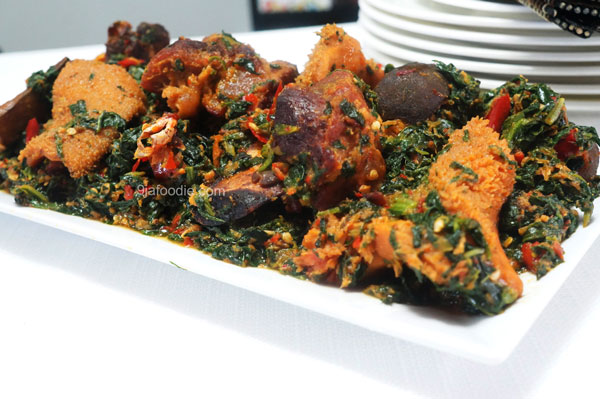Good afternoon Naija! Diet is all the rave this year and there have been several questions on Healthy Eating in Nigeria and ways to make Nigerian Recipes healthier. If we follow the general rule of thumb for a well rounded healthy diet, most recipes can be modified to become “Healthier”. Here are some useful tips
1. Stews
The way stew is prepared can easily make it one of the worst offenders; the presence of oil and fried meat in most stews is enough to drive calories and fat content overboard. Simple modification on stews will be:
- Eliminate the use of additional oil, meat has lots of naturally occurring oil
- Replace fried meat with roasted meat
- Make use of fresh fish, goat and chicken. These are leaner protein sources
- Add some ponmon to enhance the “meatyness” at lower calories
2. Rice
Rice being a grain is fundamentally healthy, where rice offends on the diet scale is in the use of “white Rice”. White rice can simply be described as “Empty food” as it is nutritionally void, low in fiber and other essential vitamins.
The simplest modification on rice would be:
- Replace white rice with Brown rice. Brown rice has 2x the manganese and Phosphorus, 2 -1/2X the iron, 3x the vitamin B3, 4x the vitamin B1, 10x the vitamin B6 and 4X the Fiber (which is essential for keeping you fuller longer)
3. Soups & Sauces
The basic composition of most soups are similar (earthy broth with meat and fish plus vegetable), again this should be fundamentally healthy but two main factors affect the health composition of most stews and sauces;
- the use of excessive Oil
- the presence of excessive high fat proteins
Although most of the calories from protein are healthy; excessive consumption can lead to weight gain and other health risks.
Some modifications for soups will include:
- Reduce the amount of oil used (a good trick is to add oil after cooking not prior)
- Be mindful of the amount of fatty proteins added (cow meat is a huge culprit)
- Use more goat meat and chicken
- Use a variety of vegetables for greater health benefits
- Replace frozen/ dried vegetables with fresh ones that are in season
4. Solids
 Wheat Fufu
Wheat Fufu
Solids are a great source of carbohydrate , the problem with solid consumption comes in the type/amount consumed. Excessive carbohydrate intake eventually leads to weight gain and other ailments. It is important to note that Carbohydrate is essential; the problem isn’t with carbohydrate itself but the types of carbohydrate. Highly processed sources like white grains are vitamin deficient and encourage excessive eating.
Instead of the popular three solid sources (Garri, pounded yam and corn fufu) , here are excellent alternatives that you can make in your own home with better nutrition:
- Millet: Millet is high in protein—1/2 cup of cooked millet provides 4.2 grams. It is also rich in niacin, B6, calcium, iron, potassium, magnesium, and zinc.
-Millet is sold on the market in whole form. Simply mill the grains in a dry mill or blender and prepare it in the same way as semolina
- Sorghum (Guinea corn): although high in calories, there are good reasons. One cup of sorghum contains 12.1 g of dietary fiber, 21.7 g of protein, 551 mg of phosphorus, 672 mg of potassium, 53.8 mg of calcium and 8.4 mg of iron.
– sorghum grains is widely sold on the market as guinea corn; simply mill the grains in a dry mill and prepare it in the same way you will prepare semolina . Go for the darker variety (black or red) for better health benefits
- Oat Fufu: Oat is high in fiber and has the magical power to remove bad cholesterol from the body. Oat is also a good source of manganese, selenium, phosphorus, fiber, magnesium and zinc
– Buy unflavored whole oat, turn it into powder form with a blender and Prepare it the same way as semolina
- Plantain Fufu : Plantains are a good source of dietary fiber, vitamin C, vitamin A, b-complex vitamins (particularly – B6) and other minerals including potassium, magnesium, phosphorous and iron.
- Milled brown rice: This is another great solid alternative that you can make in your own home; make use of local unpolished ofada rice or imported brown rice. Brown rice is simply unrefined rice; it is rich in Selenium, Manganese, fiber and other vitamins and minerals.
– Simply mill the rice grains and prepare it in the same way you will prepare semolina or tuo
- Sweet potato flour: Sweet potatoes are low in Sodium, and very low in Saturated Fat and Cholesterol. They are also a good source of Dietary Fiber, Vitamin B6, Potassium, Vitamin A, Vitamin C and Manganese.
– To make sweet potato flour, Simply dehydrate (or sun dry) raw unpeeled sweet potatoes, mill and sieve into a powder. Prepare the same way as semolina or amala
5. Protein- Meat & Alternatives:
Culturally when we think of protein, we think of meat and fish; we tend to ignore other sources of proteins like soy, nuts, beans and other legumes. The problem with animal based protein sources is the high fat/cholesterol content which can lead to disease when consumed in large amount. On the other hand, plant based protein sources are deficient in one or more essential amino acid. The best option is to combine a variety of plant and animal based protein.




No comments:
Post a Comment